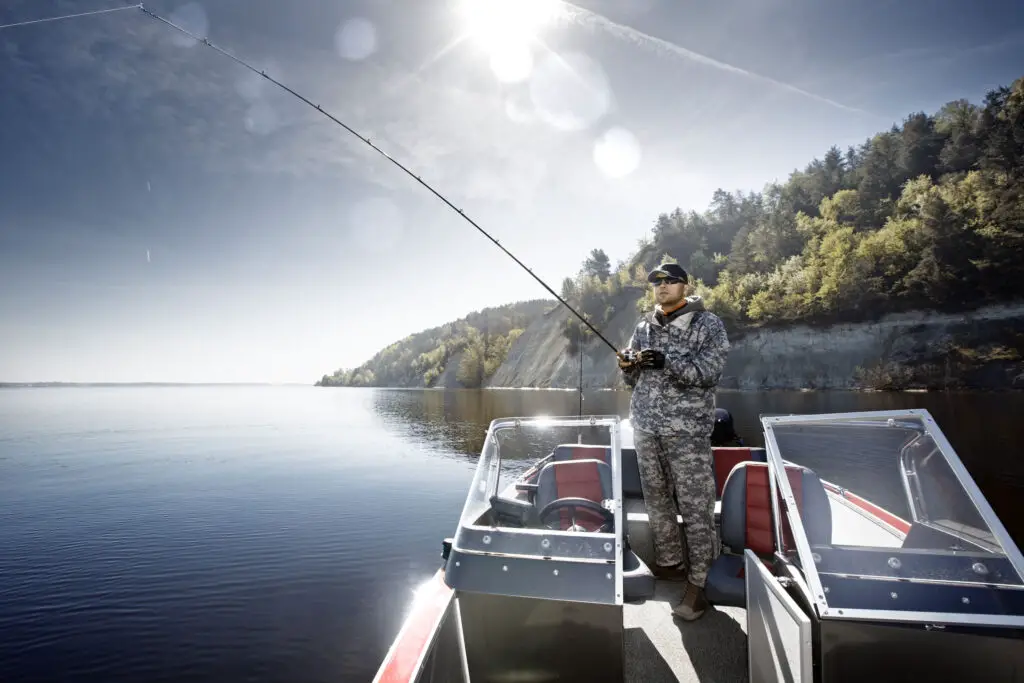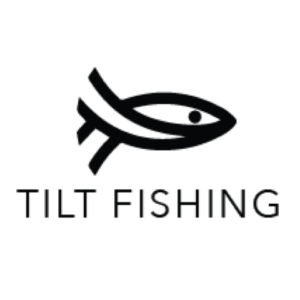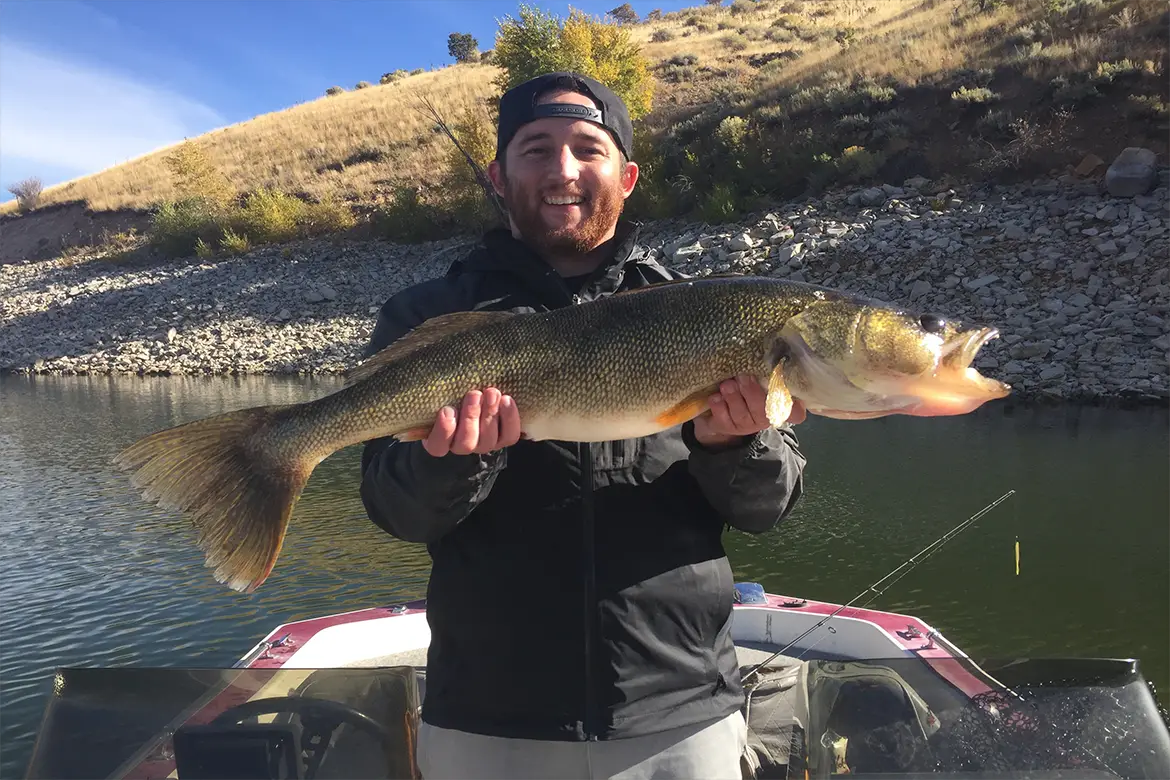One of the most important pieces of fishing equipment for any angler is their fishing line. It enables anglers to use and fish a variety of lures, baits and techniques and is their direct connection to the fish. Having the right type and size of line is extremely important and can ultimately make a huge difference.
If you are new to walleye fishing you might be wondering what type of line and pound test of line you should be using when targeting walleye. This is an important question, and the right answer may vary depending upon a few different factors.
When fishing for walleye the best pound test to use is 6-12lb fluorocarbon or monofilament. This line gives anglers the necessary strength, sensitivity, and castability needed when targeting walleye in most situations. When trolling for walleye it’s best to use either 10-14lb monofilament or braided line with a clear leader. If fishing for walleye with jigs or bait I recommend using 10-12lb fluorocarbon or monofilament. When ice fishing for walleye the best line to use is 4-8lb test.
With that being said, each walleye fishing method and technique might need a different line type and size. To learn more and really dial in the type of line you should use for walleye fishing please continue reading below.
What Pound Test to Use When Targeting Walleye
If you have ever been shopping for fishing line online or a local sporting good store, you’ll notice that there are a ton of different line options out there. With so many choices it can be difficult to know which line you should choose and fish with.
To help make sure you select the ideal line type and size for your walleye fishing adventures, I put together this following guide.
General Walleye Fishing Line Guide
| Angling Method | Pound Test | Line Type |
| General Fishing | 6-12lb | Fluorocarbon or Monofilament |
| Crankbaits | 8-12lb | Fluorocarbon or Monofilament |
| Jigs | 6-10lb | Fluorocarbon |
| Live Bait | 6-10lb | Fluorocarbon or Monofilament |
| Ice Fishing | 4-8lb | Fluorocarbon or Monofilament |
| Trolling | 8-14lb | Mono, Fluoro or Braid with leader |
Now let’s talk more in detail about the different walleye angling techniques and what is the best fishing line to use for each one.
Check out this article for more guidance on how to choose the right fishing line for each species and fishing technique: What Pound Test of Fishing Line to Use [Complete Guide]
Walleye Fishing Line by Technique
Much like other types of fishing there are several different baits, techniques and lures anglers will use when targeting walleye. With so many different ways to catch them it can be hard to keep track of what line is best for each bait and lure.
To help make things easier I’ve put together the following list of what pound test and type of line is best to use for each walleye fishing method.
Best Walley Line for Crankbaits
Casting and cranking a Rapala or similar style crankbait is one of my favorite ways to catch walleye. For this technique I find that using 10-12lb fluorocarbon is best. Some anglers prefer to use monofilament, but I like the sensitivity of fluorocarbon and the fact that it sinks which allows my crankbaits to get down deeper. With that being said 10-12lb monofilament is also a great option to use when throwing crankbaits.
Best Walley Line for Trolling
Trolling is a popular and effective way to catch walleye and cover a lot of water. For this technique, I like to fish with a little bit heavier line than I would if I was just casting and winding. The best pound test to use when trolling for walleye is 10-14lb test. I would recommend either using straight monofilament or fluorocarbon line. They are both clear, affordable and will help your crankbaits get the most action while trolling.

Best Walley Line for Ice Fishing
The best pound test of line to use when ice fishing for walleye may depend upon the baits and lures, you’ll be using. For smaller more finesse spoons and jigs lighter line between 2-6lb test is best. When ice fishing with larger lures or bait I’d recommend using 6-8lb test depending on the size and weight of your setup. I prefer to use fluorocarbon over monofilament for ice fishing, but both can work just fine.
Best Walley Line for Jigs/Tubes
Another popular and really effective way to catch walleye is with jigs and tubes. There is something about a well present jig that catches a lot of fish. For this technique the best line to use in my opinion is 8-12lb fluorocarbon line. The low stretch and sensitivity make it an ideal choice over other fishing line.
Best Walley Line for Spinners & Spoons
Spinners and spoons also be a great way to catch walleye almost anywhere. The flash, vibration and action of these lures make it hard for walleye to resist. When using spinners to spoons for walleye the perfect line to use is 6-10 monofilament or fluorocarbon line. For heavier spinners and spoons 8-10lb test is ideal. When fishing with light and smaller sized lures 6-8lb test is preferred.
Best Walleye Fishing Line
Now that we have talked about each technique and the type of line you should be using for each one, might be wondering what specific lines and brands are the best.
Here are the best fishing lines that I recommend using when fishing for walleye:
Seaguar Invizx (Fluorocarbon)

If I could only choose one fishing line to use when targeting walleye than I would choose 10-12lb Seaguar Invizx. The performance and price on this line is unreal and it’s pretty dang tough to beat. In my opinion its the perfect line to use in almost any walleye fishing situation.
It’s super sensitive, clear, and affordable. This line is a great value and is one that I would highly recommend using. I especially like it if i’m fishing with crankbaits, jigs and other reaction style fishing techniques.
Berkley Trilene XL Monofilament

Another fantastic walleye line option is the Berkley Trilene XL and its the best monofilament to use for walleye. It casts really well, is smooth and has less memory than a lot of other brands.
This line is perfect for trolling, casting, bait fishing and other walleye fishing techniques. It also has less abrasion and knots well making it ideal to handle the different demands of trolling.
Overall this is an excellent line that I would recommend to any angler looking for a good monofilament line for walleye. You won’t be disappointed.
How to Choose Walleye Fishing Line
Understanding the types of line and weight/pound test to use is really important when selecting a fishing line for walleye. It may seem like a minor thing but it can actually make a big difference.
As I mentioned previously the right type and pound test to use for walleye depends upon several factors including the caliber of fish you are targeting, size of baits and lures, and the cover and water you are fishing at.
To help you better understand how to choose the right line, I’ve put together the following information to explain more about the different things you should know and factors you should consider when selecting a fishing line.
Line Strength
The strength of a fishing line is measured by how many pounds of force it takes to break the line. The larger the pound test of the line means the more force it can take without breaking.
The downside to larger line is that it has a bigger in diameter, is more visible and tends to make baits look unnatural. Thicker line diameter gives you more strength but may be harder to get bites.
On the other hand, if you choose fishing line that has too small of pound test you can easily break off and loose fish. That’s why having the right balance is key.
Before you purchase fishing line consider what size/weight of the lures you are using, caliber of fish you are catching.
Fishing Line Type
There are three main types of fishing line that anglers will use when fishing for panfish: monofilament, fluorocarbon, and braid. Each line has its own strengths and weaknesses.
When fishing for walleye I like to use 6-12lb fluorocarbon or monofilament line. I feel like it gives me the best balance of strength, action and lack of visibility. However other anglers may have their own personal preferences.
If you really want to dial in what type of line you should use here is some more in-depth information about the different line types and the pro’s and cons of each.
Fluorocarbon
The fishing line I probably use the most is fluorocarbon. It has a smaller diameter when compared to monofilament, has less stretch, it sinks, and its lot more sensitive.
Fluorocarbon is also nearly invisible in the water which makes it a great choice in clear water. Fluorocarbon is always my preferred choice for most walleye situations the only downside is it’s a little more expensive than monofilament and won’t last as long as braid.
Monofilament
Monofilament has been the original fishing line material and has been around for what seems like forever. It has the largest diameter when compared to the other fishing line types and also has the most stretch. Monofilament is also a floating line and is pretty good at abrasion resistance.
Monofilament is a great option when you are walleye fishing with some type of live bait or are trolling. Its affordable, easy to find and works great for most walleye fishing situations.
Braid
Braided fishing line gives you the ultimate strength with zero stretch and has a really small diameter. This combination makes it great as a main line and when fishing around grass and heavy cover. Many anglers also like to use it because its harder to lose lures on it given its strength.
One of the main downsides is that its more visible in the water and can be harder to catch fish that are line shy. For this reason I suggest either using straight mono or fluoro or using braid as your main line and pairing it with a mono leader. This will give you the best of both worlds.
Determining the Size and Type of Line to Use
At this point you should be familiar with the most common fishing line used but you might be wondering which one is going to best fit you and your fishing style.
Here are some tips and things to consider that will help you determine the right line for you.
Water Clarity
The clarity of the water you are fishing in can give you a big clue on the type and size of line that is going to be best. In clear water situations less visible and lighter line will help you catch a lot more fish. Walleye are known for being line shy and if they notice something unusual about your presentation you might have a hard time getting bites.
Lighter line will also allow your lures and bait to sink easier and looks more natural in the water. For these reasons I believe fluorocarbon line is best in clear water. I would use anything between 4-12lb test depending upon the size and baits of the lures you are using.
If you are fishing in muddy or stained water the line size and visibility isn’t as big of deal, but it is something you should still think about if you are not having any luck.
Cover/Structure
Another thing to consider when selecting the right pound test and line is the type of cover and structure you plan on fishing. If you are fishing around sharpe rocks, wood, thick grass a heavier line may be needed. In these situations I like to use 12-14lb test. That way I can have confidence that my line will hold up and i’ll be able to pull fish out of the cover.
Bait & Lure Size
Perhaps the most important factor that will determine how heavy or light of line you should use when fishing for walleye is the size of bait and lures you are going to use.
This may seem obvious but you would be surprised with how many anglers overlook this when selecting a line size. The heavier your lure or bait is the more pound test you’ll need. I also like to factor in the vibration and action of the lure as well. For larger heavier baits with a lot of action I like to use 10-14lb test.
On the other hand if you are finess fishing and are using lighter jigs and baits a lighter line will be easier to manage and will help you catch more fish. In situations like these I like to use 4-8lb test.
Walleye Fishing Line Q&A
Can walleye see braided line? Much like most sport fish walleye can be very line shine. This is especially true when fishing in clear water. Braid tends to be more visible in the water when compared to other lines. For this reason, many believe walleye can see braid and may shy away from it.
Is monofilament good for walleye? Monofilament line is a popular and great line to use when fishing for walleye. It’s affordable, has a little give and is great when trolling, using bait and for other walleye fishing techniques.
Should you use a steel leader for walleye? When fishing for walleye a steel leader is not needed. In fact, it’s best to use monofilament or fluorocarbon line that is less visible. Walley do have teeth, but the right size or weight of monofilament or fluorocarbon line will be enough to land your catch.
Other Walleye Fishing Resources
- Best Colors for Walleye Lures
- An In Depth Guide to Catching Walleye in Utah
- Fishing at Night? Target These Species
Bottom Line
Choosing the right type and size of fishing line for your preferred walleye angling methods is extremely important and can play a big role in how many fish you end up landing and catching.
The right pound test of line will allow you to cast further, get to the right depth, use certain baits and techniques effectively, and ensure you can land your prized catch.
Before heading out on your next walleye fishing trip be sure you have the right line spooled up on your reals so you can confidently and effectively catch those eyes.

